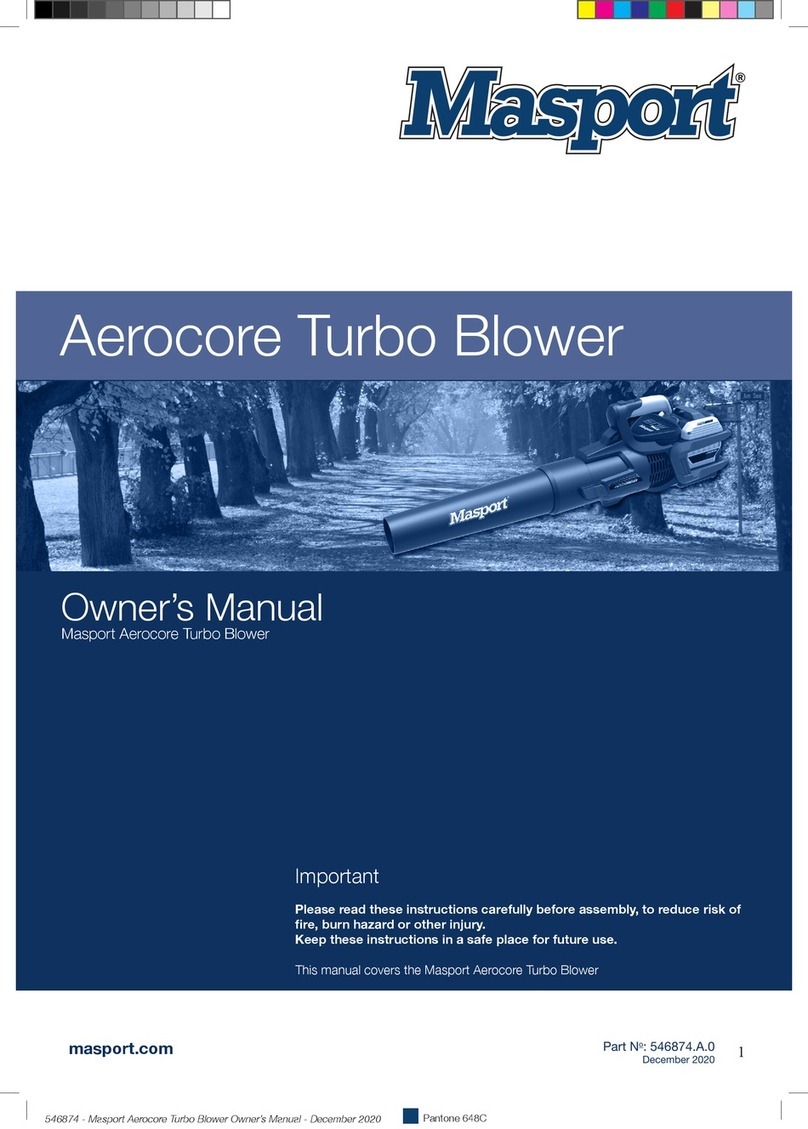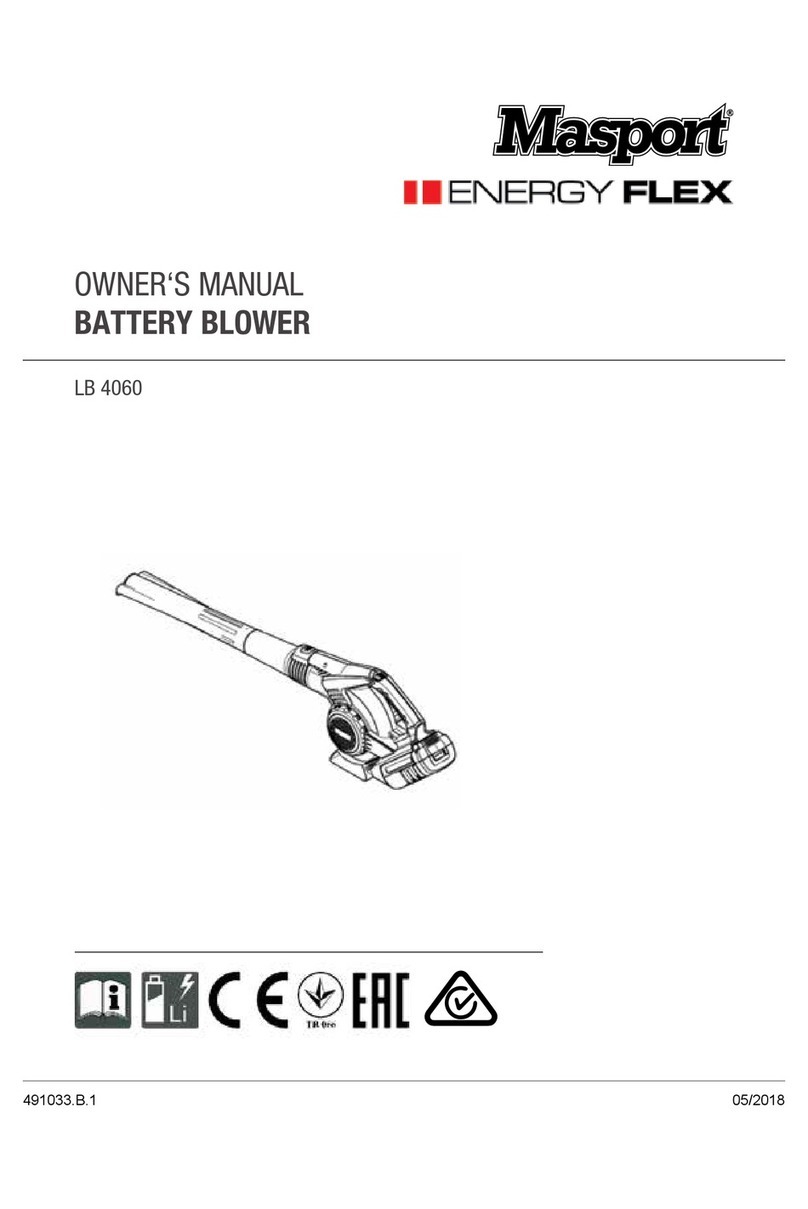
9
■ Ifyounoticeanunpleasantsensationordis-
colouration of the skin on your hands when
using the tool, stop work immediately. Take
sufficient work breaks. Without sufficient bre-
aks, a hand/arm vibration syndrome can oc-
cur.
■ Minimiseyourriskofbeingexposedtovibra-
tions. Maintain the tool according to the inst-
ructions in the operating instructions.
■ Ifthetoolisusedfrequently,contactyourde-
aler to purchase anti-vibration accessories
(e.g. handles).
■ Avoidworkingwiththetoolattemperatures
below 10 °C. Define how the vibration load
can be limited in a work plan.
3.3 Safety information regarding the
rechargeable battery
This section mentions all the basic safety instruc-
tions to be heeded when using the rechargeable
battery. Read these instructions.
■ Removetherechargeablebatteryfromthe
power tool before starting any work on the
power tool (e.g. maintenance, tool change),
before transport and before storage.
■ Onlyusetherechargeablebatteryasdesig-
nated, i.e. for Masport rechargeable bat-
tery-driven appliances. Only charge the
rechargeable battery with the Masport char-
ging unit.
■ Onlyunpackthenewrechargeablebattery
from the original packaging when it is to be
used.
■ Fullychargetherechargeablebatterybefore
using it for the first time and always use the
specified charging unit. Comply with the de-
tails given in these instructions for use for
charging the rechargeable battery.
■ Donotusetherechargeablebatteryinen-
vironments where there is a potential risk of
explosion and/or fire.
■ Donotexposetherechargeablebatteryto
moisture and humidity when in use with the
appliance.
■ Protecttherechargeablebatteryfromheat,
oil and fire to prevent it being damaged so no
vapours and electrolyte liquids can escape.
There is a danger of explosion!
■ Donotsubjecttherechargeablebatteryto
impacts or throw it.
■ Donotusetherechargeablebatterywhen
soiledorwet.Beforeuse,cleananddrythe
rechargeable battery with a dry, clean cloth.
■ Whenthebatterypackisnotinuse,keepit
away from other metal objects to prevent
bridging the contacts (e.g. paper clips, coins,
keys, nails, screws). Do not use sharp ob-
jects (e.g. a screwdriver) to work on the bat-
tery. This can cause an internal short circuit
which can lead to overheating, fire or explosi-
on of the battery.
■ Donotopen,dismantleorcrushtherechar-
geable battery. There is a danger of electric
shock and short-circuit.
■ Animproperlyusedanddamagedrecharge-
able battery can cause vapours and electroly-
te liquid to escape. Vent the room adequately
and in the case of any disorders, consult a
doctor.
If accidental contact with electrolyte liquid oc-
curs, flush with water and thoroughly rinse
the eyes immediately. Then consult a doctor.
■ Thisrechargeablebatterymustnotbeused
by unauthorised persons unless they are su-
pervised by a person responsible for their sa-
fety or have been instructed on how to use
the rechargeable battery. Unauthorised per-
sons include, for example:
■Persons (including children) with limited
physical, sensory or mental aptitude.
■Persons who have no experience and/
or knowledge of the rechargeable bat-
tery.
■ Childrenmustbesupervisedandinstructed
so they do not play with the rechargeable
battery.
■ Donotleavetherechargeablebatteryperma-
nently in the charger. For prolonged storage,
remove the rechargeable battery from the
charger.
■ Whennotinuse,removetherechargeable
batteries from the operated appliances.
■ Drytheunusedrechargeablebatteryandsto-
re in a closed place. Protect from heat and di-
rect sunlight. Unauthorised persons and chil-
dren must not have access to the recharge-
able battery.
3.4 Safety information regarding the
charging unit
This section mentions all the basic safety and
warning information to be heeded when using the
charging unit. Read these instructions.
■ Onlyusethechargingunitasdesignated,i.e.
for charging the intended rechargeable batte-
ries. Only charge original rechargeable batte-
ries from Masport in the charging unit.
■ Beforeeachuse,inspectthechargingunit,
and especially the mains cable and the
rechargeable battery compartment, for
damage. Only use the charging unit when it
is in proper working order.






























